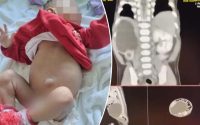I was suffering from a hidden tumor and discovered it by looking at old photos
It was looking back at photos of a Europe trip with friends at 21 that tipped Shari Dawson off that something wasn’t quite right.
She’d always had a slight overbite but, looking at the images, she realised her smile was starting to look different and her jaw had hurt.
“I would slowly notice that my top and bottom teeth would be able touch each other, whereas I would never be able to do that before,” Shari told news.com.au.
“Slowly as the years went on, it has just become quite a big underbite.”
Shari would go to medical professionals about her jaw, and began to see physiotherapists and chiropractors as her knees began to ache and her joints began to swell.
She also started getting headaches, which were attributed to her jaw pain.
“As these things popped up, I would go to a different health professional for that thing – at no time was sort of all the puzzle pieces put together,” she said.
It wasn’t until she was rushed into surgery that she realised what had been happening for almost a decade.
Shari had been out the night before, sitting around the fire with friends, when she woke up feeling like her head was exploding. She was used to migraines so she wasn’t immediately alarmed.
But, when it wouldn’t go away, she had a doctor visit to give her an injection to stop the vomiting.
“The doctor told my partner, Chris, that if I didn’t stop vomiting I had to go to the hospital,” she said.
She did, and they treated her for a migraine, but it continued for days and so she went back to the hospital.
Initially, she was diagnosed with meningitis and chills before an MRI revealed she had a pituitary tumor, which is a tumor on the gland below the brain and above the nasal passages.
It was discovered she had a rare condition called acromegaly, caused by the tumor, which meant her growth hormone was in overdrive. A famous case of this was wrestler Andre the Giant.
Shari began to go blind in her left eye, and was rushed into emergency surgery. It was a sigh of relief to know what was going on but she was also frustrated that it had taken years for the puzzle pieces to be put together.
It was initially thought that surgeons had removed everything but Shari found out there was a residual tumor in an area that was inoperable so she was put on medication, but it gave her side effects such as hair loss and severe nausea.
“It’s quite limiting because you know I had to get them done by a GP every four weeks so I couldn’t really do to anything, like go on long holidays that I used to love doing,” she said.
“I then reached out to the Australian Pituitary Foundation because at this point in the journey I just needed to talk to someone who had what I have because I had so many questions that I really only wanted the answers from other people who’ve been through exactly what I’ve been through.”
At the time, Shari was only 29. Most people are diagnosed with this disease in their 40s. She desperately wanted to know if she and Chris could have a family. She found out it is a possibility after speaking to other women, and, while it has been a hard journey with reoccurence of the acromegaly, the couple still have hope.
“At the moment, my levels do this weird thing where they’re in and out of range,” she said. And so that’s just given me a bit of lead in trying to fall pregnant and trying to have a baby through IVF.’
Shari, who is now the general manager of the Australian Pituitary Foundation, said she knew nothing about acromegaly before she was diagnosed.
She knew of gigantism, which typically occurs in children, and assumed it was a genetic condition.
“I never realized it was a condition that people can develop later in life, and that it’s because of the effect of a tumor,” she said.
“I always thought it was a genetic thing. I think that’s a common misconception with the disease.”
Shari said she wants to share her story because she thinks about what it would have been like scrolling through the internet and finding content about pituitary tumors and acromegaly when she was undiagnosed.
“I would have been like, ‘yeah, my feet have been grown and my rings don’t fit me and I have been putting on weight and my mouth is different’,” she said.
”If I could have heard about this or read about this, then maybe I would not be having to go through my fifth round of IVF to have a child. I do just think it if it can help one person receive that earlier diagnosis, then my job here is kind of done. I just want to spread some awareness around it.”


